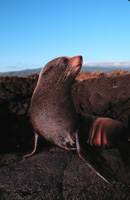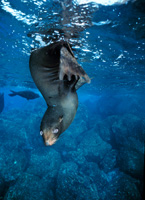Antarctic Fur Seal
(Arctocephalus gazella)

Photo: Michael Bryden,
University of Sydney
IUCN STATUS (2010) - LEAST CONCERN
|
Distribution and Numbers
|
|
| The importance of krill in the diet of Antarctic fur seals at South Georgia could result in the species being affected by an increased krill fishery in the Southern Ocean as well as by increased competition for krill with other marine mammal species that are now recovering from previous exploitation. The entanglement of Antarctic fur seals in man-made debris, particularly around the neck, is a problem as it can cause death by drowning or starvation. A 1988-1989 study at Bird Island, South Georgia, found 208 sightings of entanglement, the main culprits being polypropylene straps, nylon string and fishing net, indicating a figure of 5,000-10,000 fur seals entangled for the entire South Georgia population. The debris is most likely to come from marine traffic in the Southern Ocean. |
| In January 2000 it was reported that Chilean scientists had found Brucella antibodies in Antarctic fur seal samples and a Weddell seal sample obtained in the South Shetland Islands, the first discovery of antibodies to the serious reproductive disease Brucellosis in Antarctic seals. Unusually high levels of toxic heavy metals have also been found in Antarctic fur seals but the effects and sources of these are uncertain. Some scientists, claiming that the growing population of Antarctic fur seals is now causing environmental problems by polluting lakes and destroying plants in Antarctica, have been pushing for the downgrading of the fur seals' conservation status. |
|
| Lifestyle The breeding season takes place from November to January, the males arriving early to compete, with frequent fighting, for breeding territory that will eventually contain about 10 females. Females give birth about 2 days after arriving at the rookery and the pups are normally born in November and December with a black fur coat. |
This fur moults 2-3 months later and the pups acquire a silvery-grey coat that eventually turns grey-brown to a dark gingery colour by adulthood. Adult females and juveniles often have a creamy coloured front and the occasional seal has a creamy white colour all over. The mother mates 6-8 days after giving birth and then leaves to feed at sea, usually for 3-5 days and probably at a maximum range of 150km-240km from the breeding site, before returning to shore
|
| The main food of Antarctic fur seals at South Georgia is krill but fish, squid and even some birds are also eaten, especially outside the breeding season. The BBC (Planet Earth) has filmed fur seals preying on penguins. The almost total dependence of nursing mothers on krill during the breeding season at South Georgia means that the reproductive success of these colonies is very closely linked to its local availability. Occasionally there are years in which krill abundance is poor and colonies are affected both for that season and, to a lesser extent, for the next season. The colonies at Macquarie Island and the Kerguelen Islands rely more on a diet of fish and squid. Antarctic fur seals usually dive to a depth of 30-40m for an average of about 2 minutes, diving to a shallower depth at night, when they do most of their feeding, than during the day. Leopard seals prey on some juveniles and pups, while killer whales may also be a predator. |
|
Statistics References |
 Photo: Rodrigo Hucke-Gaete, Universidad Austral de Chile |
